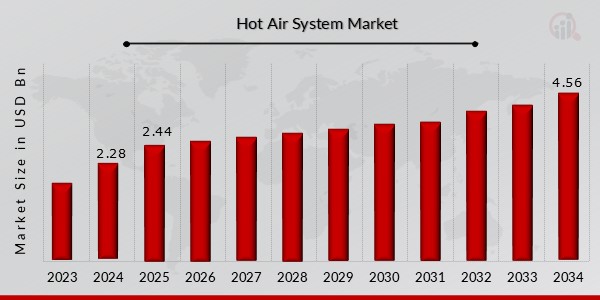The global hot air system market is experiencing significant growth, driven by a confluence of factors ranging from the increasing demand for energy-efficient heating solutions to advancements in smart technology and a growing emphasis on environmental sustainability. Once a relatively straightforward segment of the HVAC (Heating, Ventilation, and Air Conditioning) industry, hot air systems are now at the forefront of innovation, offering comfort, cost savings, and a reduced carbon footprint across residential, commercial, and industrial sectors.
The Hot Air System Market Size was estimated at 2.28 (USD Billion) in 2024. The Hot Air System Industry is expected to grow from 2.44(USD Billion) in 2025 to 4.56 (USD Billion) by 2034. The Hot Air System Market CAGR (growth rate) is expected to be around 7.2% during the forecast period (2025 – 2034).
Market Size and Growth Trajectory
- Rising Global Population and Urbanization: As populations increase and urbanization accelerates, there’s a corresponding surge in demand for new residential and commercial buildings, all requiring efficient heating solutions.
- Growing Disposable Income: Improved living standards in developing countries are leading to increased consumer spending on comfortable and luxurious home environments, including advanced heating systems.
- Replacement and Retrofitting of Old Systems: A significant portion of the market growth comes from the replacement of outdated, less efficient heating systems with modern, energy-saving hot air solutions.
- Industrial Expansion: Manufacturing plants, warehouses, and other industrial facilities require effective and uniform heating, driving demand for industrial-grade hot air systems.
Understanding Hot Air Systems
A hot air system, often referred to as a ducted air system or forced air system, functions by drawing in air, heating it (typically via a gas burner, electric coils, or heat pumps), and then distributing the warmed air throughout a space via a network of ducts, vents, and grills. A thermostat monitors the temperature and activates the system as needed. Modern systems often incorporate filters to improve indoor air quality.
Key types of hot air systems include:
- Gas-fired: These systems heat cold air over a gas flame, offering high efficiency and widespread availability of natural gas.
- Electric: Gaining traction due to convenience and ease of installation, especially when integrated with renewable energy sources like solar panels.
- Air Source Heat Pumps (ASHPs): These pull heat from outdoor air (even in cold temperatures) to warm indoor spaces. They are highly energy-efficient and contribute significantly to decarbonization efforts.
- Ground Source Heat Pumps (GSHPs): Utilizing stable underground temperatures, these systems circulate air through buried pipes to heat a home, offering exceptional efficiency.
- Hybrid Systems: Combining multiple heating technologies (e.g., a gas furnace with a heat pump) to optimize energy efficiency and fuel flexibility.
Key Market Drivers
Several powerful forces are propelling the hot air system market forward:
- Energy Efficiency and Sustainability Concerns: Governments and consumers worldwide are increasingly focused on reducing energy consumption and carbon emissions. Hot air systems, particularly those incorporating heat pump technology, offer significant energy savings and lower environmental impact compared to traditional fossil fuel-based heating.
- Strict Building Codes and Regulations: The implementation of stringent energy efficiency standards and building codes by regulatory bodies is mandating the adoption of advanced and more efficient heating solutions.
- Technological Advancements: Innovation is a major driver. The integration of smart technologies, IoT capabilities, and AI-powered controls allows for real-time monitoring, remote control, predictive maintenance, and optimized energy usage, enhancing user convenience and system performance.
- Demand for Enhanced Indoor Comfort and Air Quality: Modern hot air systems are designed to provide consistent, uniform heating and often include advanced filtration systems, catering to the growing consumer demand for comfortable and healthy indoor environments.
- Fluctuating Energy Costs: The volatility of fossil fuel prices encourages the adoption of more energy-efficient alternatives that can reduce operational expenses over the long term.
Market Segmentation
The hot air system market can be segmented based on various factors:
- Heating System Types: Central Heat, Direct Heat, Forced Air Distribution System, Hybrid Heating, Gas-fired, Air Source Heat Pump, Ground Source Heat Pump.
- Air Operation: Fresh-air operation, Mixed-air operation, Re-circulating air operation.
- End-user Applications:
- Residential: The largest segment, driven by new housing projects, retrofitting of existing homes, and the increasing demand for energy-efficient solutions in single-family and multi-family residences.
- Commercial: Widely used in office buildings, retail spaces, schools, healthcare facilities, and hospitality sectors where consistent climate control is crucial for occupant comfort.
- Industrial: Essential for maintaining optimal working conditions in manufacturing plants, warehouses, production halls, and other industrial settings, often requiring robust systems for large spaces.
- Agricultural: Niche applications in greenhouses and other climate-controlled agricultural environments.
- Fuel Type: Natural Gas, Propane, Electricity, Oil.
- Sales Channel: Direct Sales, Retail, Online.
Regional Dynamics
Geographically, the hot air system market exhibits diverse dynamics:
- North America: A significant market due to extreme cold seasons, high demand for energy-efficient solutions, and stringent regulations. The U.S. and Canada are key contributors.
- Europe: A major market with a strong focus on decarbonization and the widespread adoption of heat pumps due to supportive government policies and incentives.
- Asia-Pacific: Expected to be the fastest-growing region, driven by rapid urbanization, industrialization, and increasing construction activities in countries like China and India.
- South America and Middle East & Africa: Smaller but steadily growing markets influenced by climate, economic development, and increasing awareness of modern heating solutions.
Challenges and Opportunities
Despite its robust growth, the hot air system market faces certain challenges:
- High Initial Installation Costs: Advanced hot air systems, particularly heat pumps, can have higher upfront installation costs compared to traditional furnaces, which can deter some consumers.
- Shortage of Skilled Labor: The growing complexity of these systems necessitates a skilled workforce for installation, maintenance, and repair, and a shortage of such professionals can hinder market growth.
- Policy Inconsistencies and Regulatory Uncertainty: Shifting government policies and regulations, especially concerning subsidies and fossil fuel phase-outs, can create uncertainty for manufacturers and consumers.
- Supply Chain Disruptions: Reliance on global supply chains can lead to delays and increased costs for components and equipment.
- Integration with Existing Infrastructure: Retrofitting older buildings with new hot air systems can present technical complexities and compatibility issues.
However, these challenges also present significant opportunities:
- Technological Innovation: Continued investment in R&D to develop more affordable, efficient, and user-friendly systems.
- Hybrid Solutions: The growth of hybrid heating systems that combine the strengths of different technologies.
- Smart Home Integration: Further integration with smart home ecosystems and AI for enhanced control, automation, and energy management.
- Addressing Cold Climate Performance: Advancements in heat pump technology to improve performance in extremely cold climates.
- Government Incentives and Subsidies: Continued and expanded government support for energy-efficient heating solutions can significantly boost adoption.
- Training and Workforce Development: Initiatives to train and certify skilled technicians to meet the growing demand for installation and maintenance services.
Competitive Landscape
The hot air system market is competitive, with both global giants and specialized regional players. Key companies operating in this space include:
- Global Ballooning
Balloons International
Aerostar International
Sunrise Balloons
Balloon Adventures
AeroVista
Balloons Over America
Kubicek Balloons
Lindstrand Technologies
Rising Sun Balloons
Firefly Balloons
Sky Drifters Ballooning
These companies are actively investing in research and development, focusing on efficiency improvements, product diversification, and strategic partnerships to expand their market share.















Leave a comment